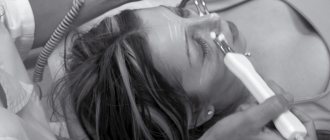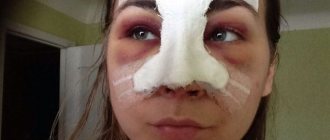Transconjunctival blepharoplasty is one of the least traumatic types of eyelid surgery, which is performed without external incisions and allows you to correct the shape of the eyes, remove fatty hernias and eliminate signs of age-related changes.
The peculiarity of transconjunctival ( sutureless ) blepharoplasty, which distinguishes it from classical blepharoplasty, is the access through the mucous membrane of the eyelid from the side of the conjunctiva. There are no incisions or traces of intervention on the outer side of the eyelid.
How to remove bags under the eyes?
With age, bags and bruises appear under the eyes, and the tone and elasticity of the eyelid skin decreases. Due to this, wrinkles are formed.
Changes in the eyelid area give a person a sad and tired look and reveal age.
Some people have bags under their eyes since childhood or adolescence and they are not associated, as many people think, with kidney problems and the like. This is a genetically determined structure of the eyelids, so to speak, an individual feature. Many women and men want to get rid of imperfections, but are afraid of surgical correction for fear of scars (in medicine they are called scars).
In many cases, transconjunctival blepharoplasty can give the eyelids a youthful appearance and remove bags under the eyes. There is no need to worry about plastic surgery marks in the eyelid area, since the operation is performed without external incisions.
Blepharoplasty of the upper and lower eyelids
Blepharoplasty is a surgical operation that corrects the shape of the eyelids and the shape of the eyes. The surgeon removes areas of skin, fat layer of the lower and upper eyelids, providing a tightening effect. The skin in this area ages first and the eyelid droops due to loss of elasticity. After 30 years, subcutaneous fat tissue also undergoes dystrophic changes - it grows and begins to sag. The look becomes tired and expressionless.
Therefore, women and men aged 40–45 who want to eliminate these cosmetic defects most often apply for blepharoplasty. By lifting the skin, the look becomes more open and the face appears younger.
Aesthetic indications for blepharoplasty
Blepharoplasty solves the following problems:
- excessive sagging of the skin of the upper eyelid;
- hernias of the lower eyelids - so-called bags under the eyes. This is a layer of fatty tissue accumulated in one place. Due to age or genetics, connective tissue septa cease to hold the lipid layer, and it begins to bulge;
- drooping corners of the eyes;
- eye asymmetry;
- sprain of the orbicularis oculi muscle;
- blepharochalasis - skin atrophy, as a result of which small wrinkled folds form above the eyelid;
- exophthalmos - excessive protrusion of the eyeball, bulging eyes;
- epicanthus - an additional fold at the inner corner of the eyelid (“Mongolian fold”).
If necessary, the plastic surgeon can slightly change the shape of the eyes.
Medical indications for blepharoplasty
An ophthalmologist will send you for reconstructive blepharoplasty if it is determined that the structure of the eyelids interferes with the functioning of the visual apparatus. Indications may be:
- ptosis of the upper eyelid - its abnormally low location;
- severe narrowing of peripheral vision due to excessive overhang of skin folds;
- entropion - inversion of the eyelid, when the eyelashes and its edge are turned towards the eyeball;
- ectropion - inversion of the tissues of the lower and upper eyelids outward.
Blepharoplasty has moved into the arsenal of plastic surgeons from ophthalmology, where similar interventions were carried out back in the century before last. However, modern technologies have made it possible to classify blepharoplasty as a one-day operation: after it, the patient can return home the next day.
Types of blepharoplasty
Tell the surgeon in detail about your expectations from permanent blepharoplasty - the doctor will take into account your anatomical features and select the optimal surgical technique. All classical technologies involve incisions with a surgical scalpel.
Upper or anchor blepharoplasty
Upper eyelid blepharoplasty is the most popular operation. Aimed at removing excess skin, fat or muscle in this area. An experienced VIP Academy surgeon will determine how much tissue needs to be excised so that the eyelids can close properly.
Lower, or subliciary, blepharoplasty
Blepharoplasty of the lower eyelid involves excision of fat bags under the eyes, and, if necessary, the skin stretched over them is removed. Sometimes the desired effect is achieved through the redistribution of fat depots.
Circular blepharoplasty
This is a simultaneous lift of the upper and lower eyelids. It takes place in several stages, lasts longer than other operations (up to 3 hours) and is considered more complex. The technique involves a highly qualified surgeon; the maximum number of defects is eliminated at a time.
Transconjunctival blepharoplasty
The surgeon can make an incision above the upper eyelashes, on the outside of the eyelid, or mini-punctures on the mucous membrane, on the inside.
In the latter case, the technology is called transconjunctival. This type of blepharoplasty allows you to achieve a high aesthetic effect, since no stitches are needed at all, which means there will be no scars. Sometimes eyelid blepharoplasty alone is not enough to correct the defect. It is combined with a surgical facelift in certain areas (frontal, superciliary, infraorbital, zygomatic or cheek areas).
Examination before blepharoplasty
Before blepharoplasty, it is necessary to undergo an examination to determine contraindications to surgery. Mandatory manipulations include:
- general blood and urine tests,
- blood chemistry,
- coagulogram - test for blood clotting,
- tests for HIV, syphilis, hepatitis B and C,
- ECG.
At the VIP Academy, patients must be examined by an ophthalmologist, because blepharoplasty is contraindicated for keratitis, blepharitis, glaucoma, and cataracts.
Anesthesia
Typically, eyelid blepharoplasty is performed under local anesthesia.
If the patient is overly anxious or has multiple allergies to local anesthetics (novocaine, lidocaine), endotracheal anesthesia is considered - that is, general. Before general anesthesia, the patient is examined by an anesthesiologist. He assesses operational risks and determines the correct anesthesia regimen.
Preparing for surgery
Eyelid blepharoplasty under local anesthesia does not require any special preparation.
On the day of surgery, you need to come to the clinic on an empty stomach and wash off all makeup from your face. Endotracheal anesthesia involves careful preparation - the patient is admitted to the hospital the day before the operation. On these days, the diet should be half-starved, and you will have to refuse dinner. The intestines are cleansed using an enema.
On the day of the intervention, you are prohibited from eating and drinking.
How is the operation performed?
The surgeon will treat the eyelids with an antiseptic solution three times, then will delimit the surgical field from the surrounding tissues with sterile material.
Injections of local anesthetic are the only painful part during surgery. While the medicine is being administered, you will feel pain and swelling of the soft tissues of the eyelid. Unpleasant symptoms will be replaced by complete insensitivity within 1–3 minutes.
Upper blepharoplasty
The surgeon will mark the skin of the upper eyelids and mark the incision lines.
In upper eyelid blepharoplasty, the tissue is cut 7–9 mm from its edge and excess skin is carefully excised. Capillary bleeding is stopped with an electrocoagulator - a device for cauterizing damaged vessels. A competent surgeon begins suturing the wound only after the bleeding has sufficiently stopped. Sutures are placed on the upper eyelid with a thin atraumatic needle strictly along the incision line.
Lower blepharoplasty
In lower eyelid blepharoplasty, the incision is made at a distance of 2–3 mm from the ciliary edge.
The skin of the lower eyelid, together with the orbicularis oculi muscle, is carefully moved down a few millimeters, opening access to the hernial sacs. They are excised, after which the skin of the lower eyelids is returned to its original position.
The surgeon excises excess skin folds near the primary incision with a single linear flap.
The last stage of lower blepharoplasty is layer-by-layer suturing of the wound of the lower eyelids. The suture is placed intradermally to avoid scarring and poor alignment of the wound edges. Our surgeons apply cosmetic sutures using modern techniques and achieve high aesthetics.
Rehabilitation
If you neglect the doctor’s recommendations during this period, the surgeon’s efforts may be in vain, and you will not get the desired effect. At first you will have to endure the inconvenience and show discipline.
The first hours after surgery
Within 3 to 4 hours after surgery, the anesthesia will wear off and you will feel mild pain in the eyelid area. You may also be concerned about:
- increased sensitivity to light,
- numbness of areas of the eyelid,
- double vision,
- increased tearfulness.
To relieve symptoms, your doctor will prescribe nonsteroidal anti-inflammatory drugs (NSAIDs). They also have an analgesic effect.
First week after surgery
On days 2–3, swelling of the soft tissues of the eyelid increases. It goes away on its own 5–7 days after blepharoplasty. Excessive swelling will help prevent simple rules:
- exclude from your diet foods that retain moisture in the body - salted, fried and smoked foods;
- reduce the amount of liquid consumed;
- avoid tilting your head and torso;
- do not engage in sports or physical labor;
- Avoid eye strain while reading, working at a computer screen or other gadgets.
These restrictions are lifted within 10–14 days after blepharoplasty.
Until the wound on the eyelid has completely healed, you should not use decorative and caring cosmetics - the products can cause an allergic reaction or inflammation. Sutures from the wound are removed on days 7–9 of the rehabilitation period.
Deferred period
The late rehabilitation period begins 2–3 weeks after blepharoplasty. At this time, the structure of the skin is gradually restored:
- swelling goes away completely;
- redness in the suture area disappears;
- new collagen fibers are formed.
The postoperative scar on the eyelids becomes invisible 1–2 months after blepharoplasty. At this time, you can already use cosmetics, so minor redness can be easily masked.
Possible complications
Most often, complications arise when the patient does not follow the doctor’s recommendations. But the surgical technique, the skill of the surgeon and the individual characteristics of the body are also of great importance.
What shouldn't scare you
Complications of blepharoplasty do not include pain and swelling - this is a physiological reaction of the body in response to trauma to the skin. After lower eyelid blepharoplasty, temporary lower eyelid separation is also possible. After 7–10 days, this phenomenon disappears, and the lower eyelid returns to its place.
What should you be wary of?
True postoperative complications include:
- hematoma formation - occurs if bleeding in the damaged tissues of the eyelid has not been sufficiently stopped;
- dry eye syndrome - tear production is impaired, the surface of the eye is not wetted by tear fluid;
- bacterial conjunctivitis;
- cysts on the suture lines;
- rough scarring of the wound - usually observed in patients prone to keloid formation. In them, any damage to the skin is accompanied by a violent reaction of the body in the form of proliferation of connective tissue.
Only some of the complications of blepharoplasty are considered to be surgical errors.
- violation of eye symmetry;
- eversion or drooping of the eyelid, incomplete closure - occurs when the surgical technique is violated, too large a musculocutaneous flap is excised;
- blindness is an extremely rare complication associated with the formation of a large hematoma in the retrobulbar space. Usually develops in the first hours after blepharoplasty
If you have any doubtful symptoms, contact your doctor immediately. The doctor will distinguish complications from the normal course of the postoperative period and prescribe therapy.
Result and forecast
The intermediate effect of blepharoplasty can be judged 2–3 weeks after surgery.
The final result is assessed 3–6 months later and lasts 8–12 years. But the skin continues to lose its elastic properties, so sometimes it may be necessary to repeat eyelid blepharoplasty ahead of schedule. In older age groups, it is often combined with a surgical facelift.
A good final effect from blepharoplasty is the result of a constructive dialogue between the doctor and the patient, the doctor’s skill and the correct rehabilitation period.
Eyelid surgery at VIP Academy is safe
Our medical center employs plastic surgeons and ophthalmological surgeons who have already performed more than 5,000 blepharoplasties.
take into account the physiology of the entire appendage apparatus of the eyes: muscles, skin and cartilage tissue of the eyelid, subcutaneous tissue and conjunctiva. The doctor accurately determines the amount of intervention in order to achieve a good result and not disrupt the function of the visual organ. We have a license from Roszdravnadzor to provide plastic surgery services.
Make an appointment with a surgeon by phone or through the website. The manager will answer additional questions via online chat.
Indications
Transconjunctival blepharoplasty of the lower eyelids is suitable for all young patients with genetically determined “bags” under the eyes and can successfully eliminate other incipient changes in the lower eyelids:
- Fatty hernias in the periorbital zone with elastic epidermis.
- Sagging skin under the eyes.
- Incipient wrinkles and folds.
- Expressiveness of the nasolacrimal groove.
- Flabbiness and loss of skin elasticity at a young age.
- Dark circles.
How does transconjunctival blepharoplasty differ from classic blepharoplasty?
As noted earlier, this operation differs from classical blepharoplasty in the localization of the access through which the plastic surgeon performs all manipulations. Thanks to this, transconjunctival blepharoplasty has the advantages of completely invisible scars and a shorter recovery period after surgery.
However, this method of lower blepharoplasty is not suitable for everyone: transconjunctival access helps in correcting mild age-related changes in the periorbital area. For example, if a patient has noticeable tissue ptosis or excess skin that requires excision, then the plastic surgeon will suggest performing a classic incision.
Preparing for surgery
I recommend that my patients get tested when the surgery date has already been set. I'll explain why.
Test results are valid for 2 weeks . Therefore, to avoid retaking them, they must be taken on the eve of the operation. In this case, they more objectively reflect the patient’s health status. And this is the key to safety and excellent results.
See the full list of tests here
Recommendations before lower eyelid blepharoplasty surgery:
- stop taking anticoagulants and anti-inflammatory drugs for 3-4 days.
- do not perform chemical peels or aggressive cosmetic procedures 2 weeks before surgery.
- Limit alcohol consumption and quit smoking within ten days.
- For 14 days, avoid exposure to the sun and do not visit the solarium.
On the day of the procedure, you need to remove your contact lenses, wash your face and not apply cosmetics.
The operation can be performed either under local anesthesia (when the surgical area is chipped) or under sedation (when the patient is “asleep”).
We choose one or another method of anesthesia with the patient during a face-to-face consultation.
Causes
There are not many reasons for complications after blepharoplasty. But they are still worth knowing:
- Individual characteristics. Allergies, location of blood vessels, individual characteristics of scar formation.
- General surgical risks. Because of them, the patient must undergo an examination before each operation.
- Failure of the patient to comply with the surgeon’s advice before and after surgery.
- Medical errors. Novice plastic surgeons underestimate the risks of surgery, believing that blepharoplasty is a technically easy procedure. This is mistake. In fact, this is one of the most difficult manipulations.
Sometimes, in the absence of actual complications, the patient remains dissatisfied with the result of blepharoplasty. This happens due to high expectations from the operation. Or the characteristics of the patient’s physiology.
Progress of lower eyelid surgery
A seamless method for lower eyelid correction involves an internal incision. The course of the operation is as follows:
- Infiltration of the tissues of the lower eyelid with a solution containing an anesthetic (for example, lidocaine or ultracaine) and a vasoconstrictor (adrenaline).
- A special protective plate (corneal cap) is placed on the eyeball.
- On the inside of the lower eyelid, an incision is made using a laser or radio scalpel along the mucous membrane - the conjunctiva (hence the name “transconjunctival”).
- Removal of hernia packages.
- Stitching. The wound is sutured using self-absorbing threads.
- Applying an antibacterial eye patch.
The duration of the operation is from half an hour to one and a half hours.
Types of blepharoplasty
Plastic surgeons at the Pirogov Clinic perfectly perform all types of eyelid correction operations.
We make sure that a beautiful and natural result pleases our patients for years, therefore we give preference to modern minimally invasive techniques and fat-preserving blepharoplasty .
The peculiarity of the latter is that during the operation, fatty tissue in the periorbital area is not completely removed, but is evenly redistributed under the skin. This allows you to maintain good skin quality - prevent aging, dryness, and avoid the “bulging eyes” effect. After blepharoplasty, lipofilling of the eyelids can be performed for the purpose of additional biorevitalization of the skin and correction of volume deficits.
Rehabilitation after transconjunctival blepharoplasty
The patient remains under the supervision of specialists for 3-5 hours. The bandage is removed after a day.
Tearing and burning of the mucous membrane for several days is normal. Every day it is necessary to treat the eyes in a special way several times. There's nothing complicated about it. Patients cope with it easily. It consists of instilling antibacterial drops into the eyes.
To reduce the risk of negative consequences and accelerate tissue regeneration, you must follow the following recommendations for one month:
- Wear sunglasses when going outside.
- You should not apply makeup for about a week.
- It is necessary to sleep in a reclining position to reduce swelling.
- You should refrain from working at the computer, reading and other activities that increase eye strain.
- When washing your face, you need to make sure that soap suds do not get into your eyes.
- Contact lenses should be replaced with glasses.
- It is advisable to use patches that relieve swelling from the eyelids.
- You cannot visit the bathhouse, swimming pool or solarium.
You can return to your normal routine after ten days. The final result is assessed after thirty days.
Possible complications after surgery
Any surgical intervention is fraught with complications, both through the fault of the doctor and the fault of the patient or his individual reactions.
In the case of eyelid surgery, this may include headaches or double vision due to increased eye pressure. Often this phenomenon is associated with the very fact of the intervention and should go away on its own. However, if the patient is bothered by any deviations from the norm for a long time, he should immediately consult a doctor.
Various types of hematomas require immediate surgical intervention, as they can lead to irreversible consequences. Usually a puncture and forced removal of blood are prescribed. To avoid such consequences, you need to very carefully choose a clinic and a doctor for eyelid surgery.
If the surgeon removes too much tissue, the eyelid may turn out. In professional language this is called “ectropion of the eyelid” (inversion of the eyelid). To eliminate this complication, a repeat operation is required.
Tearfulness occurs when the tear ducts are displaced or pinched. Sometimes this effect goes away on its own, but you may need medical help after consulting an ophthalmologist.
Rare complications include harmless cysts that resolve on their own. A more complex complication is tissue scarring, which practically does not occur with transconjunctival blepharoplasty, except for the individual reaction of the patient.
Circular blepharoplasty
The combination of blepharoplasty of the upper and lower eyelids will allow you to solve all problems at once during one operation.
The full scope of eyelid correction allows you to achieve the most pronounced effect. Circumferential blepharoplasty is often performed in conjunction with a facelift (facelift) or other anti-aging surgeries.
Read more about the service
Here
Why is it worth getting blepharoplasty at the Pirogov Clinic (St. Petersburg)?
- The Pirogov Clinic was recognized as the best plastic surgery clinic according
to the national rating of private clinics in St. Petersburg by the medical portal “Doctor Peter” and the city portal “Fontanka.ru” in 2021; - Our team of specialists includes experienced plastic surgeons, doctors of the highest category, winners of prestigious awards
- online consultations with plastic surgeons;
- free consultations with plastic surgeons;
- affordable prices for eyelid blepharoplasty;
- the opportunity to undergo all preoperative examinations in the clinic within one day;
- own laboratory: test results - quickly and with a guarantee of reliability;
- equipping operating rooms with the most advanced medical equipment from leading Western companies;
- attentive and responsible medical staff: a team of anesthesiologists, resuscitators, assistants and nurses coordinately and quickly resolves any issues around the clock;
- modern comfortable hospital: you feel like you are in a European hotel room;
- quick recovery after blepharoplasty;
- the ability to perform several operations simultaneously, which means you get the best result in one surgical intervention;
- the cosmetology and laser dermatology departments carry out procedures for the fastest possible tissue regeneration, allowing you to start enjoying the results as soon as possible;
- interest-free installment payment for any operations, credit;
- discounts on services under VHI policies.
Sign up for a consultation and we will help you find a new look!
Make an appointment










